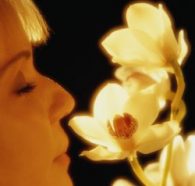Making sense of scents
Different smells light up different parts of the brain.
The nose knows. Your sense of smell can quickly alert you to freshly baked, chocolate chip cookies, a fragrant flower, or a stinky pair of socks.
Now, scientists have a better idea of how the brain makes sense of all these scents. Particular smells appear to turn on particular combinations of brain cells, researchers suggest.
 |
|
|
When your nose catches a whiff of something, one of 1,000 different types of odor-receiving cells picks it up. These cells send an electrical signal to a region of the brain called the olfactory bulb. From there, the message is transmitted to a smell-specific section of the cortex, the part of the brain that handles thinking and perception.
To see what happens when smell messages hit the cortex, a group of scientists studied mouse brains. The researchers first exposed the mice to distinctive scents, such as vanilla, apples, or fish. They then examined thin slices of each mouse’s brain, looking for which brain cells had been turned on by each odor.
The scientists discovered that aromas activate a number of cells scattered throughout the smell cortex. Each scent produces a similar pattern of active cells in different mice. So, a certain combination of cells tells a mouse that it’s smelling vanilla, apples, fish, or any one of thousands of other odors.
The investigators also found that when mice smell a stronger scent, it activates more cells over a larger area. And when they looked at how mouse brains light up after the animals smell two scents that are similar, the patterns are similar as well.
This points to a sort of logic behind how smells activate the cortex, the researchers suggest. Scientists could use studies like this to create a map of which parts of the brain are activated by different smells.
Another smell scientist, however, says that researchers should also do studies on animals that don’t live in a lab, but have spent their lives smelling things in the natural world. With more smelling experience, they might show quite different patterns.—K. Ramsayer
Going Deeper:
Brownlee, Christen. 2005. Mapping aroma: Smells light up distinct brain parts. Science News 167(May 28):340-341. Available at http://www.sciencenews.org/articles/20050528/fob4.asp .
You can learn more about how smell works at science.howstuffworks.com/question139.htm (How Stuff Works).